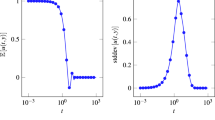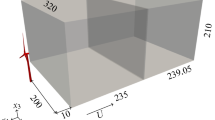Abstract
The stream function and the velocity potential can be easily computed by solving the Poisson equations in a unique way for the global domain. Because of the various assumptions for handling the boundary conditions, the solution is not unique when a limited domain is concerned. Therefore, it is very important to reduce or eliminate the effects caused by the uncertain boundary condition. In this paper, an iterative and adjusting method based on the Endlich iteration method is presented to compute the stream function and the velocity potential in limited domains. This method does not need an explicitly specifying boundary condition when used to obtain the effective solution, and it is proved to be successful in decomposing and reconstructing the horizontal wind field with very small errors. The convergence of the method depends on the relative value for the distances of grids in two different directions and the value of the adjusting factor. It is shown that applying the method in Arakawa grids and irregular domains can obtain the accurate vorticity and divergence and accurately decompose and reconstruct the original wind field. Hence, the iterative and adjusting method is accurate and reliable.
Similar content being viewed by others
References
Hawkins, H. F. and Rosenthal, S. L. On the computation of stream function from the wind field. Mon. Wea. Rev., 93(4), 245–252 (1965)
Lü, M. Z., Hou, Z. M., and Zhou, Y. Dynamic Meteorology (in Chinese), Meteorological Press, Beijing, 113–114 (2004)
Frederiksen, J. S. and Frederiksen, C. S. Monsoon disturbances, intraseasonal oscillations, teleconnection patterns, blocking, and storm tracks of the global atmosphere during January 1979: linear theory. J. Atmos. Sci., 50(10), 1349–1372 (1993)
Knutson, T. R. and Weickmann, K. M. 30–60 day atmospheric oscillations: composite life cycles of convection and circulation anomalies. Mon. Wea. Rev., 115(7), 1407–1436 (1987)
Lorenc, A. C., Ballard, S. P., Bell, R. S., Ingleby, N. B., Andrews, P. L. F., Barker, D. M., Bray, J. R., Clayton, A. M., Dalby, T., Li, D., Payne, T. J., and Saunders. F. W. The Met. Office global 3-dimensional variational data assimilation scheme. Quart. J. Roy. Meteor. Soc., 126, 2991–3012 (2000)
Barker, D. M., Huang, W., Guo, Y. R., Bourgeois, A. J., and Xiao, Q. N. A three-dimensional (3DVAR) data assimilation system for use with MM5: implementation and initial results. Mon. Wea. Rev., 132(4), 897–914 (2004)
Bourke, W. An efficient one-level primitive equation spectral model. Mon. Wea. Rev., 100(9), 683–689 (1972)
Bijlsma, S. J., Hafkensheid, L. M., and Lynch, P. Computation of the stream function and the velocity potential and reconstruction of the wind field. Mon. Wea. Rev., 114(8), 1547–1551 (1986)
Tangri, A. C. Computation of streamlines associated with a low latitude cyclone. Indian J. Meteor. Geophys., 17, 401–406 (1966)
Phillips, N. A. Geostrophic errors in predicting the Appalachian storm of November 1950. Geophysica, 6, 389–405 (1958)
Brown, J. A. and Neilon, J. R. Case studies of numerical wind analysis. Mon. Wea. Rev., 89(3), 83–90 (1961)
Sangster, W. E. A method of representing the horizontal pressure force without reduction of station pressures to sea level. J. Meteor., 17(2), 166–176 (1960)
Sangster, W. E. An improved technique for computing the horizontal pressure-gradient force at the Earth’s surface. Mon. Wea. Rev., 115(7), 1358–1368 (1987)
Shukla, J. and Saha, K. R. Computation of non-divergent stream function and irrotational velocity potential from the observed winds. Mon. Wea. Rev., 102(6), 419–425 (1974)
Lynch, P. Deducing the wind from vorticity and divergence. Mon. Wea. Rev., 116(1), 86–93 (1988)
Lynch, P. Partitioning the wind in a limited domain. Mon. Wea. Rev., 117(7), 1492–1500 (1989)
Chen, Q. S. and Kuo, Y. H. A harmonic-sine series expansion and its application to partitioning and reconstruction problems in a limited area. Mon. Wea. Rev., 120(1), 91–112 (1992)
Chen, Q. S. and Kuo, Y. H. A consistency condition for wind-field reconstruction in a limited area and harmonic-cosine series expansion. Mon. Wea. Rev., 120(11), 2653–2670 (1992)
Zhu, Z. S. and Zhu, G. F. An effective method to solve the stream function and the velocity potential from a wind field in a limited area (in Chinese). Quart. J. Appl. Meteor. Sci., 19(1), 10–18 (2008)
Zhu, Z. S., Zhu, G. F., and Zhang, L. An accurate solution method of the stream function and the velocity potential from the wind field in a limited area (in Chinese). Chinese J. Atmos. Sci., 33(4), 811–824 (2009)
Zhou, Y. S., Cao, J., and Gao, S. T. The method of decomposing wind field in a limited area and its application to typhoon SAOMEI (in Chinese). Acta Phys. Sin., 57(10), 6654–6665 (2008)
Zhou, Y. S. and Cao, J. Partitioning and reconstruction problem of the wind in a limited region (in Chinese). Acta Phys. Sin., 59(4), 2898–2906 (2010)
Endlich, R. M. An iterative method for altering the kinematic properties of wind fields. J. Appl. Meteor., 6(5), 837–844 (1967)
Davies-Jones, R. On the formulation of surface geostrophic stream function. Mon. Wea. Rev., 116(9), 1824–1826 (1988)
Li, Z. J. and Chao, Y. Computation of the stream function and the velocity potential for limited and irregular domains. Mon. Wea. Rev., 134(11), 3384–3394 (2006)
Liu, J. W., Guo, H., Li, Y. D., Liu, H. Z., and Wu, B. J. The Basis of Weather Analysis and Prediction Physical Quantity Calculation (in Chinese), China Meteorologica Press, Beijing, 249–251 (2005)
Zhang, W. S. Finite Difference Methods for Partial Differential Equations in Science Computation (in Chinese), Higher Education Press, Beijing, 172 (2004)
Arakawa, A. Computational design for long-term numerical integrations of the equations of fluid motion: two-dimensional incompressible flow, part l. J. Comput. Phys., 1(1), 119–143 (1966)
Watterson, I. G. Decomposition of global ocean currents using a simple iterative method. J. Atmos. Ocean. Technol., 18(4), 691–703 (2001)
Author information
Authors and Affiliations
Corresponding author
Additional information
Project supported by the National Natural Science Foundation of China (No. 40975031)
Rights and permissions
About this article
Cite this article
Li, Ab., Zhang, Lf., Zang, Zl. et al. Iterative and adjusting method for computing stream function and velocity potential in limited domains and convergence analysis. Appl. Math. Mech.-Engl. Ed. 33, 687–700 (2012). https://doi.org/10.1007/s10483-012-1580-9
Received:
Revised:
Published:
Issue Date:
DOI: https://doi.org/10.1007/s10483-012-1580-9




